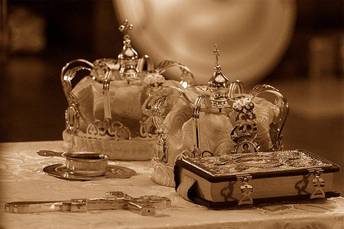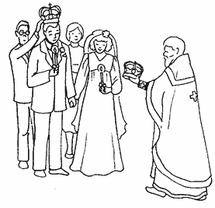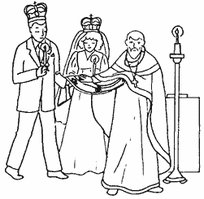The Sacrament (Mystery) of Marriage

Click to Enlarge
The family is the basic unit or 'cell' of society, and the Christian family is also a major building block of the Orthodox Church. The Church places greet importance on the family to fulfil its role as a small church, as expressed by the Apostle Paul. When St. Paul greeted Priscilla and Aquila, his "fellow workers in Christ Jesus" he also greeted "the church that is in their house" (Romans 16:3, 5). He also greeted "Nymphas and the church that is in his house" (Col 4:15).
Monasticism is also another major Christian social unit. The Church places this unit above married life as monasticism has played an important role as the guiding element in Her history. Monasticism supports the Church, preserves Her dogmas and keeps the Divine Liturgy Orthodox. While the Church blesses the monastic life, She also blesses marriage knowing that not all can take on the responsibility and commitment that comes with celibacy and living a monastic life. This blessing is acknowledged as a Mystery (Sacrament) of the Church.
In the Mystery of Marriage the Church asks God to help the couple being married understand, fulfil and establish a 'church' at home, i.e. to establish Christian relationships within the family, to raise children in the faith and life according to the Scriptures, to be an example of humility and patience for your children to follow.
The Christian family begins with the Mystery of Marriage, and specifically with the exchange of rings and placing of the wedding crowns (wreaths) upon those being married. This is accompanied with the words, "The servant of God N____ is married to the servant of God N____ in the name of the Father and of the Son and of the Holy Spirit", and then, "O Lord our God, crown them with glory and honour". The rings have a deep symbolic meaning. This symbolism is indicated with the words, from the Service of Betrothal, "Through a ring the authority was given to Joseph in Egypt; through a ring Daniel was glorified in the land of Babylon; through a ring the true identity of Thamar was discovered; through a ring our heavenly Father showed mercy on the prodigal son; for he said, Put a ring on his fingerÉ". The crowns and their exchange symbolise the couple's citizenship in the Kingdom of God, where "there is neither male nor female" (Gal. 3:28), and of their dying to each other (c.f. Rev. 2:10).
The Holy Scriptures tell us that God "blessed" marriage from the beginning of time saying "Be fruitful and increase in number; fill the earth" (Gen. 1:27-28), showing that marriage is part of God's eternal purpose for humanity. Further on, in Genesis 2:24, we read, "Therefore a man will leave his father and mother and be united to his wife, and they will become one flesh". Our Lord Jesus Christ reiterated these words when asked if it is lawful for a man to divorce his wife. He continued, "So then, they are no longer two but one flesh. Therefore what God has joined together, let not man separate" (Matt. 19:4-6).
Christ forever sanctified marriage by His presence at the marriage in Cana of Galilee (John 2:1-11). This was the first time Christ performed a miracle, and the first time the Theotokos interceded with Christ on behalf of others saying, "They have no wine", and then instructs all humanity, "Whatever He say to you, do it".
The Apostle Paul compares the Mystery of Marriage with the Church in these words, recited during the Crowning Service, "Husbands, love your wives, just as Christ also loved the Church and gave Himself for her", and "for this reason a man shall leave his father and mother and be joined to his wife, and the two shall become one flesh. This is a great mystery, but I speak concerning Christ and the church" (Eph. 5:25, 31-32). In 1 Corinthians 7, St. Paul gives detailed guidance on virginity and marriage. He also commands that marriage should be preserved.
Thus, marriage is holy, blessed and everlasting sacrament in the sight of God and His Church.
Finally, history closes with marriage of the Bride to the Lamb (Rev. 19:7-9), thus fulfilling the earthly marriage in the heavenly, showing the eternal nature of marriage.
Reference - The Orthodox Study Bible, p449
Copyright © 1993 by St. Athanasius Orthodox Academy, Nelson ISBN 0-8407-8391-4
MORE ON SACRAMENT OF THE HOLY MATRIMONY
HOLY MATRIMONY is a one of the Mysteries of the Holy Orthodox Church in which a man and woman are united by the Holy Trinity. Their conjugal union is blessed by our Lord Jesus Christ through the Church. God's grace is imparted to them to live together in His love, mutually fulfilling and perfecting each other.The Mystery of marriage of the Holy Orthodox Church is steeped in ritual and symbolism. Each of the acts has special meaning and significance.
The rings
The rings are blessed by the priest who takes them in his hand and, making the sign of the cross over the heads of bride and groom, says: "The servant of God ...is betrothed to the maid of God ... in the name of the Father, of the Son, and of the Holy Spirit."The couple then exchange the rings, taking the bride's ring and placing it on the groom's finger and vice-versa. The rings, of course, are the symbol of betrothal and their exchange signifies that in married life the weaknesses of the one partner will be compensated for by the strength of the other, the imperfections of one by the perfections of the other. By themselves, the newly-betrothed are incomplete: together they are made perfect. Thus the exchange of rings gives expression to the fact that the spouses in marriage will constantly be complementing each other. Each will be enriched by the union.
The candles
The Wedding service begins immediately following the Betrothal Service. The bride and groom are handed candles which they hold throughout the service. The candles are like the lamps of the five wise maidens of the Bible, who because they had enough oil in them, were able to receive the Bridegroom, Christ, when He came in the darkness of the night. The candles symbolize the spiritual willingness of the couple to receive Christ, Who will bless them through this Mystery.
The joining of the right hands
The right hand of the bride and groom are joined when the priest reads the prayer that beseeches God to "join these thy servants, unite them in one mind and one flesh." The hands are kept joined throughout the service to symbolize the "oneness" of the couple
Monasticism is also another major Christian social unit. The Church places this unit above married life as monasticism has played an important role as the guiding element in Her history. Monasticism supports the Church, preserves Her dogmas and keeps the Divine Liturgy Orthodox. While the Church blesses the monastic life, She also blesses marriage knowing that not all can take on the responsibility and commitment that comes with celibacy and living a monastic life. This blessing is acknowledged as a Mystery (Sacrament) of the Church.
In the Mystery of Marriage the Church asks God to help the couple being married understand, fulfil and establish a 'church' at home, i.e. to establish Christian relationships within the family, to raise children in the faith and life according to the Scriptures, to be an example of humility and patience for your children to follow.
The Christian family begins with the Mystery of Marriage, and specifically with the exchange of rings and placing of the wedding crowns (wreaths) upon those being married. This is accompanied with the words, "The servant of God N____ is married to the servant of God N____ in the name of the Father and of the Son and of the Holy Spirit", and then, "O Lord our God, crown them with glory and honour". The rings have a deep symbolic meaning. This symbolism is indicated with the words, from the Service of Betrothal, "Through a ring the authority was given to Joseph in Egypt; through a ring Daniel was glorified in the land of Babylon; through a ring the true identity of Thamar was discovered; through a ring our heavenly Father showed mercy on the prodigal son; for he said, Put a ring on his fingerÉ". The crowns and their exchange symbolise the couple's citizenship in the Kingdom of God, where "there is neither male nor female" (Gal. 3:28), and of their dying to each other (c.f. Rev. 2:10).
The Holy Scriptures tell us that God "blessed" marriage from the beginning of time saying "Be fruitful and increase in number; fill the earth" (Gen. 1:27-28), showing that marriage is part of God's eternal purpose for humanity. Further on, in Genesis 2:24, we read, "Therefore a man will leave his father and mother and be united to his wife, and they will become one flesh". Our Lord Jesus Christ reiterated these words when asked if it is lawful for a man to divorce his wife. He continued, "So then, they are no longer two but one flesh. Therefore what God has joined together, let not man separate" (Matt. 19:4-6).
Christ forever sanctified marriage by His presence at the marriage in Cana of Galilee (John 2:1-11). This was the first time Christ performed a miracle, and the first time the Theotokos interceded with Christ on behalf of others saying, "They have no wine", and then instructs all humanity, "Whatever He say to you, do it".
The Apostle Paul compares the Mystery of Marriage with the Church in these words, recited during the Crowning Service, "Husbands, love your wives, just as Christ also loved the Church and gave Himself for her", and "for this reason a man shall leave his father and mother and be joined to his wife, and the two shall become one flesh. This is a great mystery, but I speak concerning Christ and the church" (Eph. 5:25, 31-32). In 1 Corinthians 7, St. Paul gives detailed guidance on virginity and marriage. He also commands that marriage should be preserved.
Thus, marriage is holy, blessed and everlasting sacrament in the sight of God and His Church.
Finally, history closes with marriage of the Bride to the Lamb (Rev. 19:7-9), thus fulfilling the earthly marriage in the heavenly, showing the eternal nature of marriage.
Reference - The Orthodox Study Bible, p449
Copyright © 1993 by St. Athanasius Orthodox Academy, Nelson ISBN 0-8407-8391-4
MORE ON SACRAMENT OF THE HOLY MATRIMONY
HOLY MATRIMONY is a one of the Mysteries of the Holy Orthodox Church in which a man and woman are united by the Holy Trinity. Their conjugal union is blessed by our Lord Jesus Christ through the Church. God's grace is imparted to them to live together in His love, mutually fulfilling and perfecting each other.The Mystery of marriage of the Holy Orthodox Church is steeped in ritual and symbolism. Each of the acts has special meaning and significance.
The rings
The rings are blessed by the priest who takes them in his hand and, making the sign of the cross over the heads of bride and groom, says: "The servant of God ...is betrothed to the maid of God ... in the name of the Father, of the Son, and of the Holy Spirit."The couple then exchange the rings, taking the bride's ring and placing it on the groom's finger and vice-versa. The rings, of course, are the symbol of betrothal and their exchange signifies that in married life the weaknesses of the one partner will be compensated for by the strength of the other, the imperfections of one by the perfections of the other. By themselves, the newly-betrothed are incomplete: together they are made perfect. Thus the exchange of rings gives expression to the fact that the spouses in marriage will constantly be complementing each other. Each will be enriched by the union.
The candles
The Wedding service begins immediately following the Betrothal Service. The bride and groom are handed candles which they hold throughout the service. The candles are like the lamps of the five wise maidens of the Bible, who because they had enough oil in them, were able to receive the Bridegroom, Christ, when He came in the darkness of the night. The candles symbolize the spiritual willingness of the couple to receive Christ, Who will bless them through this Mystery.
The joining of the right hands
The right hand of the bride and groom are joined when the priest reads the prayer that beseeches God to "join these thy servants, unite them in one mind and one flesh." The hands are kept joined throughout the service to symbolize the "oneness" of the couple
The crowning

The service of the Crowning, which follows, is the climax of the Wedding service. The crowns are signs of the glory and honor with which God crowns them during the Mystery. The groom and the bride are crowned as the king and queen of their own little kingdom, the home - domestic church, which they will rule with fear of God,wisdom,justice and integrity.When the crowning takes place the priest, taking the crowns and holding them above the couple, says:"The servants of God, (names), are crowned in the name of the Father, and of the Son, and of the Holy Spirit. Amen." The crowns used in the Orthodox wedding service refer to the crowns of martyrdom since every true marriage involves immeasurable self-sacrifice on both sides.
The common cup
The service of crowning is followed by the reading of the Epistle and the Gospel. The Gospel reading describes the marriage at Cana of Galilee which was attended and blessed by our Lord and Saviour Christ, and for which He reserved His first miracle. There He converted the water into better wine and give of it to the newlyweds, in remembrance of this blessing, wine is given the couple. This is the "common cup" of better life denoting the mutual sharing of joy and sorrow, the token of a life of harmony. The drinking of wine from the common cup serves to impress upon the couple that from that moment on they will share everything in life, joys as well as sorrows, and that they are to "bear one another's burdens." Their joys will be doubled and their sorrows halved because they will be shared.
The common cup
The service of crowning is followed by the reading of the Epistle and the Gospel. The Gospel reading describes the marriage at Cana of Galilee which was attended and blessed by our Lord and Saviour Christ, and for which He reserved His first miracle. There He converted the water into better wine and give of it to the newlyweds, in remembrance of this blessing, wine is given the couple. This is the "common cup" of better life denoting the mutual sharing of joy and sorrow, the token of a life of harmony. The drinking of wine from the common cup serves to impress upon the couple that from that moment on they will share everything in life, joys as well as sorrows, and that they are to "bear one another's burdens." Their joys will be doubled and their sorrows halved because they will be shared.
The walk

The priest then leads the bride and groom in a circle around the table on which are placed the Gospel and the Cross, the one containing the Word of God, the other being the symbol of our redemption by our Saviour Jesus Christ. The husband and wife are taking their first steps as a married couple, and the Church, in the person of the priest, leads them in the way they must walk. The way is symbolized by the circle at the center of which are the Gospel and the Cross of our Lord. This expresses the fact that the way of Christian living is a perfect orbit around the center of life, who is Jesus Christ our Lord.During this walk around the table a hymn its sung to the Holy Martyrs reminding the newly married couple of the sacrificial love they are to have for each other in marriage - a love that seeks not its own but is willing to sacrifice its all for the one loved.
The blessing
The couple return to their places and the priest, blessing the groom, says, "Be thou magnified, O bridegroom, as Abraham, and blessed as Isaac, and increased as Jacob, walking in peace and working in righteousness the commandments of God." And blessing the bride he says, "And thou, O bride, be thou magnified as Sarah, and glad as Rebecca, and do thou increase like unto Rachael, rejoicing in thine own husband, fulfilling the conditions of the law; for so it is well pleasing unto God."
The blessing
The couple return to their places and the priest, blessing the groom, says, "Be thou magnified, O bridegroom, as Abraham, and blessed as Isaac, and increased as Jacob, walking in peace and working in righteousness the commandments of God." And blessing the bride he says, "And thou, O bride, be thou magnified as Sarah, and glad as Rebecca, and do thou increase like unto Rachael, rejoicing in thine own husband, fulfilling the conditions of the law; for so it is well pleasing unto God."
